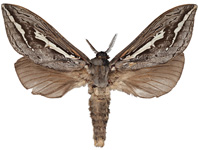Abstract
Abantiades cephalocorvus sp. nov. and Abantiades tembyi sp. nov. are described, along with the previously undescribed females of A. macropusinsulariae Simonsen, 2018 and A. pallida Simonsen, 2018. All of these species belong to a triforked Abantiades Herrich-Schäffer clade that is loosely centred around the Nullarbor and other arid regions of Australia. We explore DNA barcodes (mtDNA COI gene) from these and other Abantiades and discuss their significance for species recognition. The species distributions are entirely or largely allopatric and we discuss their origins from a widespread common ancestor that was likely distributed over inland and coastal regions in the mid- to late-Mesozoic before the onset of desertification. Notes on new distributional data for all of the known species in this clade are included.
References
Beaver, E.P., Moore, M.D., Velasco-Castrillón, A. & Stevens, M.I. (2020) Three new ghost moths of the genus Oxycanus Walker, 1856 from Australia (Lepidoptera: Hepialidae). Zootaxa, 4732 (3), 351–374.
https://doi.org/10.11646/zootaxa.4732.3.1
Dorey, J.B., Schwarz, M.P. & Stevens, M.I. (2019) Review of the bee genus Homalictus Cockerell (Hymenoptera: Halictidae) from Fiji with description of nine new species. Zootaxa, 4674 (1), 1–46.
https://doi.org/10.11646/zootaxa.4674.1.1
Drummond, A.J., Ho, S.Y.W., Phillips, M.J. & Rambaut, A. (2006) Relaxed phylogenetics and dating with confidence. PLoS Biology, 4 (5), 699–710.
https://doi.org/10.1371/journal.pbio.0040088
Drummond, A.J., Suchard, M.A., Xie, D. & Rambaut, A. (2012) Bayesian phylogenetics with BEAUti and the BEAST 1.7. Molecular Biology and Evolution, 29, 1969–1973.
https://doi.org/10.1093/molbev/mss075
Dugdale, J.S. (1994) Hepialidae (Insecta: Lepidoptera). Fauna of New Zealand, Canterbury, New Zealand, 30, 1–164.
Dumbleton, L.J. (1966) Genitalia, classification, and zoogeography of New Zealand Hepialidae (Lepidoptera). New Zealand journal of science, 9 (4), 920–981.
Folmer, O., Black, M., Hoeh, W., Lutz, R. & Vrijenhoek, R. (1994) DNA primers for amplification of mitochondrial cytochrome c oxidase subunit I from diverse metazoan invertebrates. Molecular Marine Biology and Biotechnology, 3, 294–299.
Grund, R., Stolarski, A. & Stevens, M.I. (2019) Rediscovery of Synemon selene (Lepidoptera: Castniidae) in the mid-north of South Australia. Transactions of the Royal Society of South Australia, 143, 86–91.
https://doi.org/10.1080/03721426.2018.1532270
Herrich-Schäffer, G.A.W. ([1843]–1856) Systematische Bearbeitung der Schmetterlinge von Europa, zugleich als Text, Revision und Supplement zu Jakob Hübner‘s Sammlung europäischer Schmetterlinge. Vol. 6. „Nachtrag zum ersten Bande“. G. J. Manz, Regensburg, 178 pp. [pp. 1–24 (1851) + 25–80 (1852) + 81–152 (1855) + 153–178 (1856)]
Kumar, S., Stecher, G., Li, M., Knyaz, C. & Tamura, K. (2018) MEGA X: Molecular Evolutionary Genetics Analysis across computing platforms. Molecular Biology and Evolution, 35, 1547–1549.
https://doi.org/10.1093/molbev/msy096
Lanfear, R., Frandsen, P.B., Wright, A.M., Senfeld, T. & Calcott, B. (2016) PartitionFinder 2: new methods for selecting partitioned models of evolution for molecular and morphological phylogenetic analyses. Molecular Biology and Evolution, 34 (3), 772–773.
https://doi.org/10.1093/molbev/msw260
Moore M.D. (2014) Two further new species of Abantiades Herrich-Schäffer (Lepidoptera: Hepialidae) from Western Australia. Australian Entomologist, 41 (4), 217–231.
Moore, M.D., Beaver, E.P., Velasco-Castrillón, A. & Stevens, M.I. (2020) Four new species of triforked Abantiades Herrich-Schäffer (Lepidoptera: Hepialidae) from the “dark obscura clade”. Zootaxa, 4801 (1), 115–141.
https://doi.org/10.11646/zootaxa.4801.1.5
Rambaut, A., Drummond, A., Xie, D., Baele, G. & Suchard, M. (2019) Tracer. Version 1.6. Available from: http://beast.bio.ed.ac.uk/Tracer (accessed 20 June 2019)
Simonsen, T.J. (2018) Splendid Ghost Moths and Their Allies. Monographs on Australian Lepidoptera, 12, i–xii + 1–300.
https://doi.org/10.1071/9781486307487
Simonsen, T.J., Moore, M.D., Dupont, S.T. & Stevens, M.I. (2019) Testing DNA barcodes against morphology for the ‘tripectinate Abantiades’ (Lepidoptera: Hepialidae) reveals a complex relationship between COI sequence data and morphology. Austral Entomology, 58, 792–799.
https://doi.org/10.1111/aen.12395
Stephens, J.F. (1828) Illustrations of British Entomology; or, A Synopsis of Indigenous Insects: Containing their generic and specific distinctions; with an account of their metamorphoses, times of appearance, localities, food, and economy as far as practicable. Haustellata. II. Baldwin and Cradock, London, 80 pp., pls. 13–18.
https://doi.org/10.5962/bhl.title.8133
Tindale, N.B. (1932) Revision of the Australian Ghost Moths (Lepidoptera, Homoneura, Family Hepialidae) Part 1. Records of the South Australian Museum, IV (4), 500–505.
Tindale, N.B. (1938) Ghost Moths of the Family Hepialidae. South Australian Naturalist, 19, 1–6.
Walker, F. (1856) List of the specimens of Lepidopterous Insects in the collection of the British Museum. Lepidoptera Heterocera, 7, 1508–1808. [incl. Index to parts 1–7]


